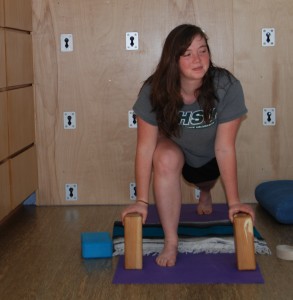Therapy means ‘self-care’!
So at the most fundamental level, all yoga is self-care.
And yoga, when practiced as a lifestyle, nourishes your greatest potential for optimal health and well-being.
However, yoga, as practiced in mainstream America, is not a panacea for all life’s problems. In fact, many people have become injured as a result of yoga practices, primarily due to improper physical alignment in poses, repetitive strain injuries, and doing poses and practices that are not suited to them. A true balanced yoga regime engages a range of yogic principles and practices that helps to heal and balance all layers of our Being: physical, emotional, mental and spiritual. It is also tailored to one’s personality, fitness level, age/stage of life, time of day and conditions or challenges happening in one’s life.
Although a yoga class is more affordable for most yoga practitioners, it is not necessarily the best option for you, as an individual, to achieve your greatest, potential.
In this article, I will review the important aspects to consider for your physical yoga practice.
The most common arena within which most people participate in yoga is within a class that engages physical postures (=asana). So physical fitness has been a primary focus and gain through yoga towards a level of fitness that heretofore was declining into obesity and health problems associated with inactivity and stress, prevalent conditions of contemporary living. However, due to many factors, not every yoga participant has had excellent results regarding their physical health with yoga. Many people have experienced injuries in yoga. Why?
One of the chief factors contributing to injuries is improper alignment. When joints are not aligned properly, one can suffer injury immediately, as substantial weight is put on an area that isn’t meant to withstand the impact of , typically, dead weight.  Such is the case when shoulder stand, head stand and/ or variations thereof (including bridge, plow) are engaged without proper external supports (like blankets / blocks), and the yoga student does not engage appropriate muscle groups to support lift. Typically the neck is tweaked, and anyone who has experienced such a trauma, knows it takes a while to return to stability and heal, if in fact the injury is ever completely resolved without any subsequent issues. One needs to learn these more risky poses from an experienced teacher, as they are very beneficial, if done properly.
Such is the case when shoulder stand, head stand and/ or variations thereof (including bridge, plow) are engaged without proper external supports (like blankets / blocks), and the yoga student does not engage appropriate muscle groups to support lift. Typically the neck is tweaked, and anyone who has experienced such a trauma, knows it takes a while to return to stability and heal, if in fact the injury is ever completely resolved without any subsequent issues. One needs to learn these more risky poses from an experienced teacher, as they are very beneficial, if done properly.
 Another problem with misalignment, is when poses are engaged incorrectly over and over again; say you attend a class 3x/week, doing the plank pose with improper shoulder engagement as you move from down-dog to plank to up-dog/cobra, then this becomes an injury over time… a repetitive stress injury. I have seen, heard and read of this problem arising primarily within yoga classes that engage a lot of sun salutations throughout their routine. But this can happen for anyone if every time they do any of the warrior poses, lunges and any pose where a knee is bent, and not in proper alignment relative to the hip and ankle joints. Repetitive strain here can cause knee problems, or add to predispositions for imbalances already within the legs (like bow or knock-knees), thereby reinforcing the problem, inevitably creating injury over time. It is essential to understand and incorporate proper alignment of all the joints, including that of the spine.
Another problem with misalignment, is when poses are engaged incorrectly over and over again; say you attend a class 3x/week, doing the plank pose with improper shoulder engagement as you move from down-dog to plank to up-dog/cobra, then this becomes an injury over time… a repetitive stress injury. I have seen, heard and read of this problem arising primarily within yoga classes that engage a lot of sun salutations throughout their routine. But this can happen for anyone if every time they do any of the warrior poses, lunges and any pose where a knee is bent, and not in proper alignment relative to the hip and ankle joints. Repetitive strain here can cause knee problems, or add to predispositions for imbalances already within the legs (like bow or knock-knees), thereby reinforcing the problem, inevitably creating injury over time. It is essential to understand and incorporate proper alignment of all the joints, including that of the spine.
So what is my recommendation? Go to an alignment-based class, and/or workshops and/or private sessions with an experienced alignment-based teacher; these are typically from an Iyengar, Anusara or Viniyoga tradition, wherein you learn what proper alignment is for you. Then, you practice holding or engaging rhythmic movements to increase the strength and flexibility where it is needed for your body. For example, if you come into Warrior 2, with proper alignment, you practice holding that alignment as you move into triangle pose, then go back and forth between the two poses, maintaining alignment. Once you have embodied this knowledge, then you can bring this to whatever type of class you choose to participate in. Hopefully you will avoid the pitfalls, and only gain the physical benefits from your efforts in a yoga class. Let’s keep yoga as self-nourishing for your physical body.
